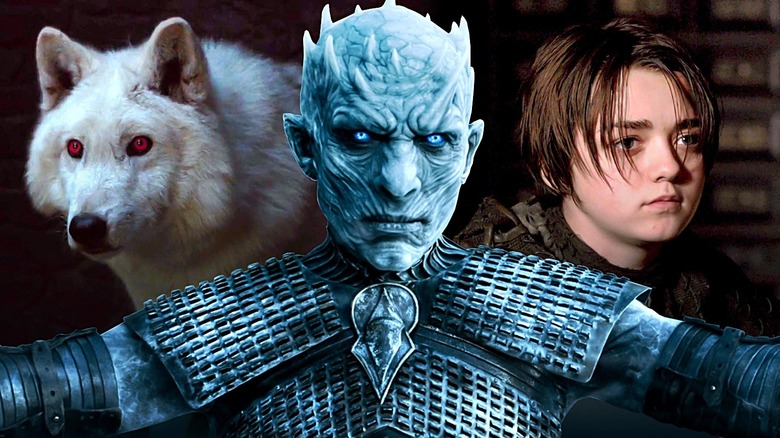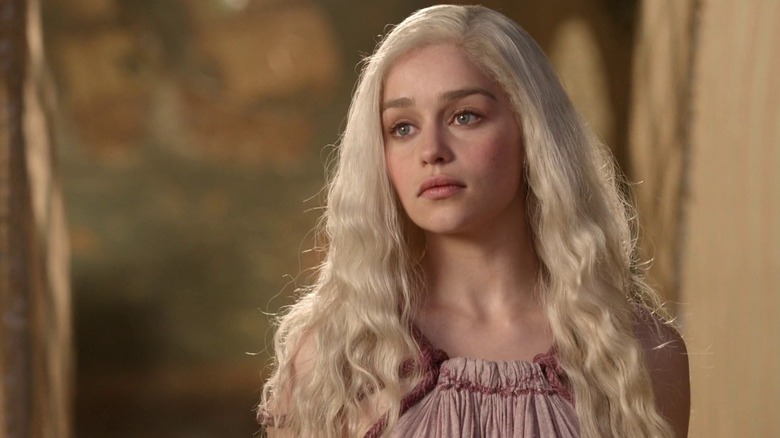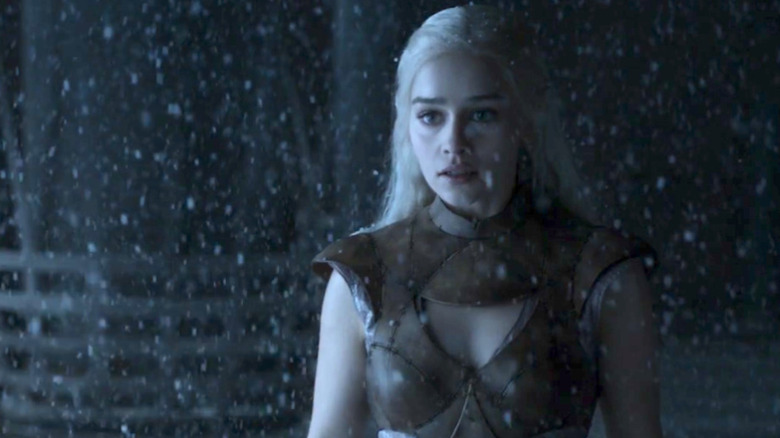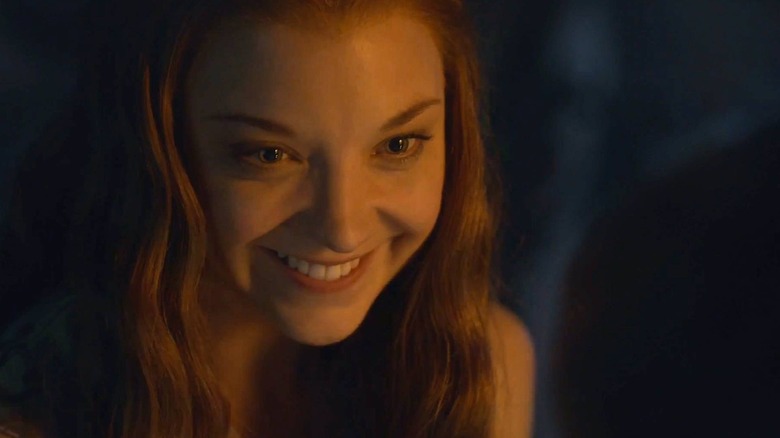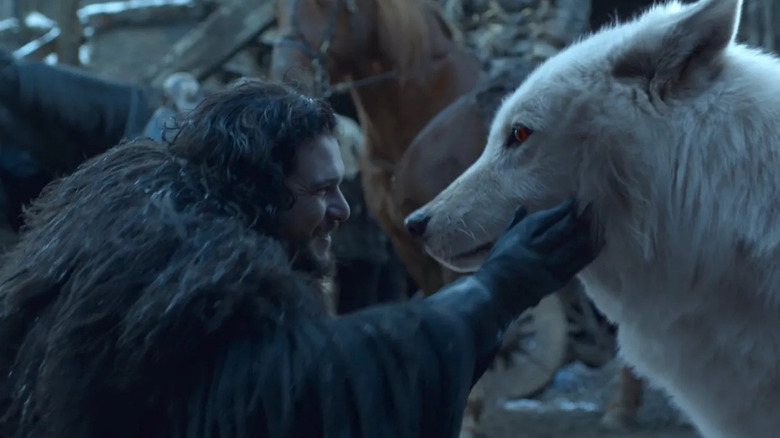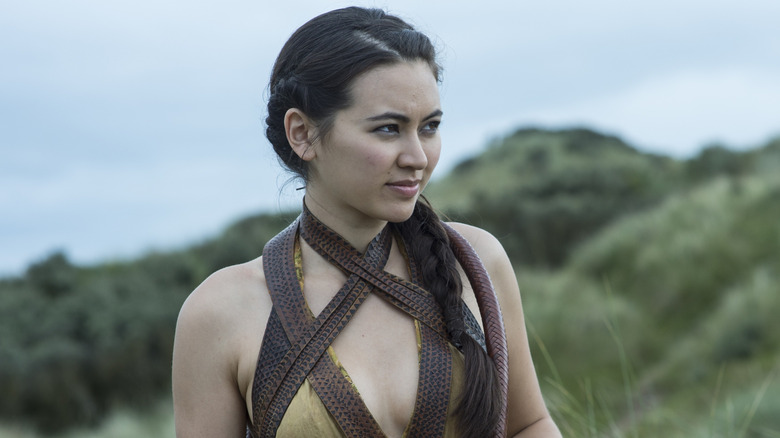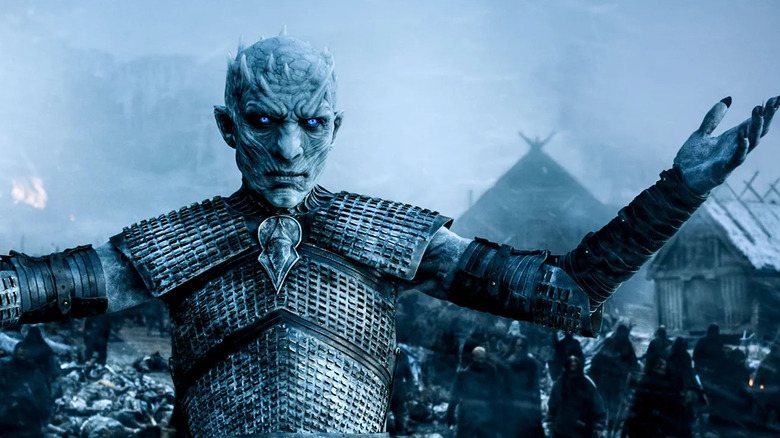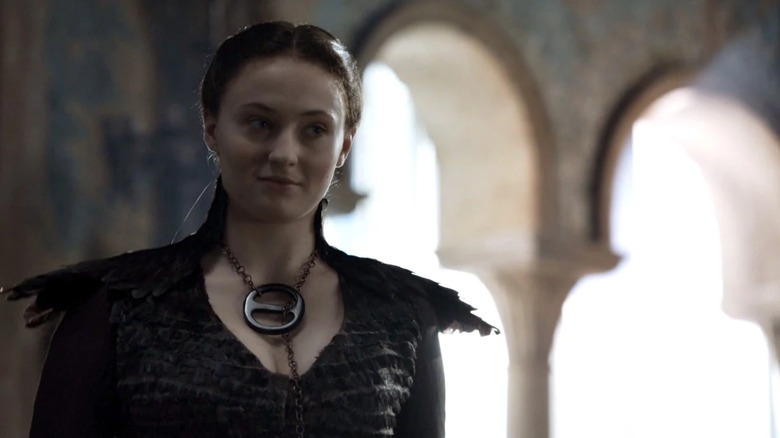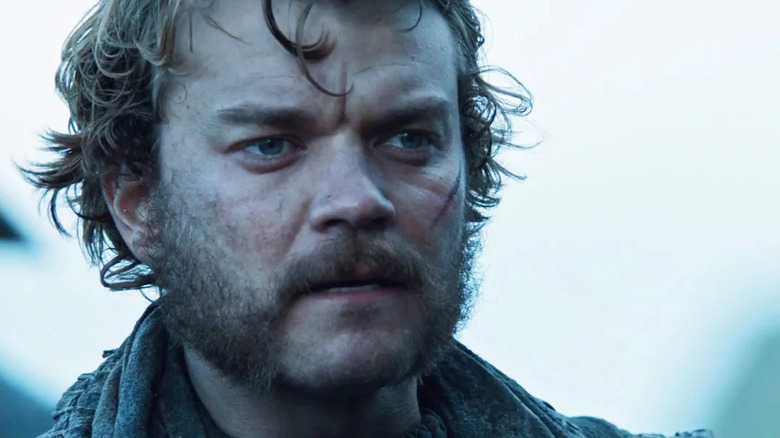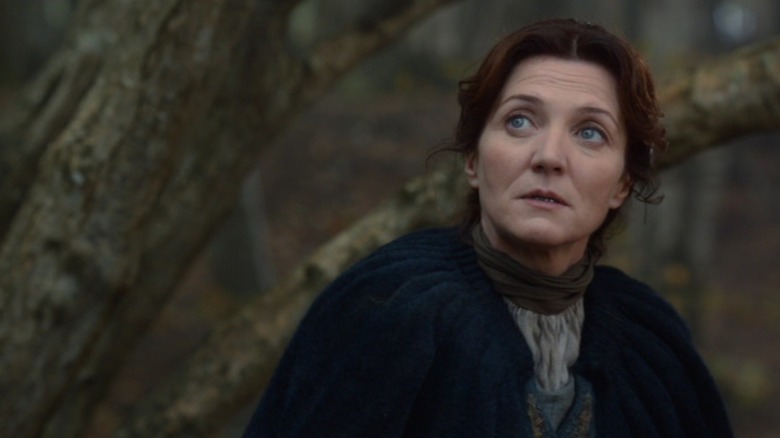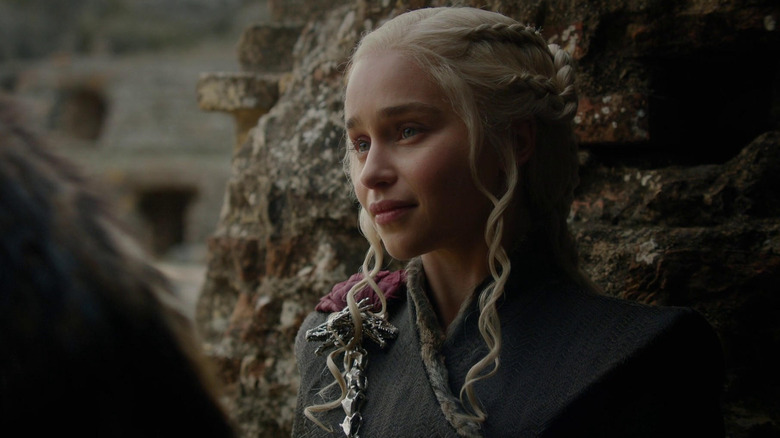12 Biggest Differences Between HBO's Game Of Thrones And George R. R. Martin's Books
It's been years since "Game of Thrones" ended, bringing the HBO series' tight grip on pop culture to a close (if only temporarily). The show took TV by storm in the 2010s, with characters like Daenerys Targaryen, Jon Snow, and Tyrion Lannister becoming household names. However, it owed a lot to the books it was based on, "A Song of Ice & Fire" by George R. R. Martin.
Although the television series was predated by five books, the show quickly moved past where they left off, resulting in a second half of the series that is divisive amongst fans. Some speculate that every main character's ending in "Game of Thrones" is reminiscent of how they'll end up on the page, but the show still took drastic creative liberties along the way, from cutting integral characters to simplifying Martin's overcomplicated plots.
We're now 14 years out from the most recent book's release, and while some still hope "Game of Thrones" will have a very different ending in the books, the likelihood that "The Winds of Winter" will be finished continues to dwindle. In case you're desperate for more "Game of Thrones," here are the big differences you should be prepared for when starting to read "A Song of Ice & Fire."
Spoiler warning for "Game of Thrones" and "A Song of Ice & Fire," so beware!
Characters were aged up for the show
Even for "Game of Thrones," some things from George R. R. Martin's books were deemed too inappropriate for audiences. In the original "A Game of Thrones" released in 1991, a lot of the characters are quite young, and they were aged up for the show in order to make certain storylines more palatable for a modern audiences. For instance, Robb Stark was originally 14-years-old in the books, but to make his transition to military leader at the end of season 1 more sensible, his age was increased to 17 in the series.
A more notorious example of this change is Daenerys Targaryen, who is in her early teens when she's sold by her brother Viserys to Khal Drogo in book one. Like Robb, Daenerys' age for the show was changed to be 17, which is especially a better choice considering how many of the early episodes depict Dany's sexual relationship with Drogo. Dany's actress, Emilia Clarke, was well into her 20s by this point, and only a few years older than Tamzin Merchant, who was originally cast as Daenerys in the unaired HBO pilot for "Game of Thrones."
Of course, little about the characters' actions from the books change as a result of their ages, as it's merely just a cosmetic difference so that the showrunners weren't depicting graphic violence and nudity among minors.
Arya's mentorship with Tywin wasn't in the books
One of the most beloved side plots of "Game of Thrones" was, surprisingly, not a part of George R. R. Martin's books at all. While held captive at Harrenhal in season 2, Arya Stark is forced to be a cupbearer for Tywin Lannister. Despite Tywin actively fighting a war against Arya's family, he and Arya form an unlikely bond, despite Tywin having no idea that she's the missing little sister of his enemy.
In the books, Tywin is never present at Harrenhal. Arya is instead taken as the steward for Weese, who is only seen briefly in the show. Unlike Tywin, Weese is abusive towards Arya, causing her to whisper his name to Jaqen H'ghar for him to be killed. The rest of the Harrenhal plot with Arya is similar to the show, in which she persuades Jaqen to help free her and her friends from captivity in exchange for his life.
Even though Maisie Williams' dedication to the "Game of Thrones" books made her job a lot harder, having a huge on-screen relationship with an actor like Charles Dance was formative. As she told The Hollywood Reporter, Dance would always stay on set while Williams was having her coverage shot for their scenes together, saying, "He taught me that acting in an ensemble cast like 'Game of Thrones' is all about working as a team."
The House of the Undying foreshadowed a different future for Daenerys
Even though "Game of Thrones" suffered in its later seasons due to poor planning, a lot was correctly foreshadowed in the season 2 finale, when Daenerys enters The House of the Undying and experiences several visions: a decimated Iron Throne room in King's Landing, a venture beyond the Wall, and a reunion with Khal Drogo and her unborn child. Ultimately, she frees herself from the illusions after commanding her dragons to torch Pyat Pree.
However, Dany's visions in "A Clash of Kings" made many preposterous "Game of Thrones" fan theories plausible, including foreshadowing future plot points like the Red Wedding, as well as Dany's freeing of slaves and the existence of Aegon Targaryen (more on that later). This is also where the prophecy of "the prince who was promised" was introduced, fueling many theories of Dany and Jon Snow's significance to the story and each other.
Finally, the Undying deliver a prophecy to Daenerys, saying she must light three fires (for life, for death, for love), ride three mounts (to bed, to dread, to love), and face three betrayals (for blood, for gold, for love). There are plenty of theories for what these prophecies are referencing in the books, but it's not surprising that, given their absence in the show, the writers stuck with simpler visions that were easier to fulfill in the final season.
The show fleshed out Margaery's political savviness
One of the best "Game of Thrones" characters was Margaery Tyrell, played brilliantly by Natalie Dormer. The Tyrells become valuable allies to the Lannisters when Margaery is set to wed Joffrey, and after his assassination, his younger brother Tommen. The show depicts her as a cunning and promising political mastermind, but in the books, Margaery's not a POV character, meaning she's only depicted through the eyes of characters like Sansa Stark or Cersei Lannister.
As a result, many scenes with Margaery in the show were invented to give her character more layers than in the book, including one memorable scene after Joffrey's death where she visits Tommen in his bedroom, slowly setting the seeds for their wedding. The only time the books ever reveal more than meets the eye about Margaery is when Cersei visits her during her imprisonment by the High Sparrow, and Margaery accuses her mother-in-law of framing her. In season 6 of the show, Margaery outsmarts Cersei by allying with the Faith of the Seven, only to be killed in a mass murder by wildfire.
Given how smart show Margaery had proven herself, many fans think she's one of many "Game of Thrones" characters who deserved a better ending. Nevertheless, an ending like that would make much more sense for book Margaery, who is still smart but less fleshed out than her show counterpart.
Jon Snow can warg into Ghost
The "Game of Thrones" finale made Bran Stark the King of Westeros, mostly because, unlike all the other characters, he can see everything as a warg. The show had spent 8 seasons building up Bran's importance as a greenseer, allowing him to project his consciousness into animals like his dire wolf Summer and even humans like Hodor. However, as far as the books go, Bran's not even the only character in his own family capable of warging.
As early as book 2, Jon Snow is shown to be able to warg into Ghost, his albino dire wolf. This is even instrumental in his acceptance into the Wildlings, given that he can use his ability to warg to help do reconnaissance. However, this ability is completely ignored in the show. Though, in all fairness it's not as integral to his story as it is for Bran. Nevertheless, many fans have theorized that, in the books, Jon may survive his assassination attempt through warging, given that his last words are "Ghost."
There's a lot of missed potential with not including Jon's warging in the series. When you consider the revelations of Jon Snow's family tree in "Game of Thrones," it's especially a missed opportunity to not have Jon capable of warging into a dragon, as a result of his joint Stark and Targaryen heritage.
The Dorne plot is completely different in the books
None of the seven kingdoms in "Game of Thrones" are as synonymous with bad writing as Dorne, which plays a major role in the fifth season. After prince Oberyn Martell is killed in a trial-by-combat with the Mountain, his bastards, the Sand Snakes, plot revenge, while Oberyn's more cautious brother Prince Doran attempts to keep the peace by marrying his son Quentyn to Cersei's daughter, Myrcella, only for her to be assassinated by Ellaria Sand.
In "A Feast for Crows," the fourth book in "A Song of Ice & Fire," the Dorne plot is not only very different, but it has entire POV characters who are completely absent from the show. One such POV character is Arianne Martell, daughter of Prince Doran, who schemes with her lover, Sir Arys Oakheart, to crown Myrcella on the Iron Throne, only for their conspiracy to be thwarted by her father out of allegiance to the Targaryens.
It's not necessarily surprising that fans, whether they had read the books or not, hated the Dorne storyline, as it's just an unnecessary change that rids the show of some of the most interesting characters from the books. They even wasted the casting of Jessica Henwick, star of "The Matrix Resurrections" and Marvel's "Iron Fist," as one of the Sand Snakes.
Melisandre rescues Mance Rayder from execution in the books
At times, Melisandre appears to be one of the more enigmatic characters in "Game of Thrones." Perhaps that's due to the performance by Carice van Houten, who perfectly captures the seductive sorceress' vibe from the books. But from the character's introduction to her exit in season 8, audience members were scratching their heads as to her real motivations, plans, and magical powers. However, a key plot point involving Melisandre was not only cut out of season 5, but it completely changes the trajectory of her character.
Notably, the fifth season of "Game of Thrones" kicks off with the execution of Mance Rayder, the wildling leader whom Jon mercy-kills out of compassion, by Stannis Baratheon and Melisandre. However, in the books, Melisandre has used illusion-casting to actually kill a Wildling named Rattleshirt disguised as Mance Rayder, which the real Mance had sent by Jon Snow and Melisandre to rescue Arya (or who they're told is Arya anyway) from being wed to Ramsay in Winterfell.
The last book readers had heard from Mance, his mission to free Arya had ended in failure, and he was captured by Ramsay, who taunts Jon Snow in a letter just before Jon is assassinated. Meanwhile, show watchers were unaware of Mance's continued relevance in the books, given that his death in the show isn't any type of illusion.
The Night King was invented for the show
Before being unceremoniously killed by Arya in "The Long Night," the Night King was set up to be the biggest threat facing Westeros in "Game of Thrones." The White Walkers are introduced in the very first scene of the series (or the prologue of the first book), but it isn't until season 4 that fans got a glimpse at their leader, who later appears during season 5's "Hardhome," raising the undead wildlings as he taunts Jon Snow.
The thing is, the Night King is completely absent from George R. R. Martin's books. The Night King's name may be derived from an ancient Lord Commander of the Night's Watch, who, according to lore, married a female white walker. It's possible that the showrunners felt this major threat needed a "big bad" to represent them, but by the final season, the white walkers seemed like a plot contrivance that's easily done away with.
The only depth we got about who the Night King is was in season 6, when we learned he was once a human who, after being captured by the Children of the Forest, was turned into a white walker. Their origin has yet to be revealed in the books, so it's safe to say that since "Game of Thrones" changed other important aspects of the white walkers, the Night King may never appear in the books.
Sansa doesn't marry Ramsay in the books
Many audience members of "Game of Thrones" rightfully criticized the fifth season for its plot line where Sansa Stark is married off to the abusive Ramsay Bolton, especially considering it was coming off the heels of season four, in which it felt like Sophie Turner's character had finally started to gain agency. Although it set her character on a path to becoming a once-in-a-century ruler with everything you need in a queen, it all came out of left field, most likely because it's not the direction her character is heading in the books.
In fact, the character who marries Ramsay in the books is... Arya Stark? No, it's actually Sansa's childhood friend Jeyne Poole, disguising herself as Arya, though the only person who knows this is Theon Greyjoy, who has been Ramsay's captive. Jeyne, who doesn't even appear in the show, is the recipient of Ramsay's cruel abuse, while Sansa is miles away, completely oblivious.
After partnering up with Littlefinger, just as it happens in season 4 of "Game of Thrones," Sansa goes undercover as Alayne Stone, taking up residence in the Eyrie and becoming Littlefinger's mentee. It's all a slow-burning plot for Sansa and Littlefinger to reclaim Winterfell, which, like in the show, is currently occupied by the Boltons. Thankfully the books are smart enough to keep Sansa on a course towards empowerment.
The book version of Euron Greyjoy is much scarier
Book fans were incredibly excited to see the sixth season of "Game of Thrones" introduce Pilou Asbæk as Euron Greyjoy, the mischievous brother of Balon Greyjoy and uncle to Theon and Yara (named Asha in the books). However, it didn't take many appearances in season 6 to establish that the show's Euron was going to be a lot different than what book readers were expecting.
In the books, Euron is the embodiment of evil, having killed Balon in order to claim the throne of the Iron Islands. He's not only an incredibly dangerous warmonger, but Euron is in possession of the dragonhorn, which is said to be able to tame dragons, potentially setting him up to be a major player in the wars to come. However, all the mystique and intrigue in Euron from the books was pretty much thrown away for the show, which introduces him as a foul-mouthed pirate who allies with Queen Cersei.
Even by the final season, Euron serves little purpose other than to pop out of nowhere and kill one of Daenerys' dragons before being anti-climactically killed by Jaime Lannister in the penultimate "The Bells." It's a shame the character was done so dirty by the show, because his role in the books is so promising.
Catelyn Stark returns with a vengeance in the books
One of the more notorious changes made by "Game of Thrones" was the exclusion of Lady Stoneheart, the reanimated version of Catelyn Stark after she was killed in the Red Wedding. According to the showrunners, Lady Stoneheart wasn't included to avoid having too many resurrections, knowing they'd be using that plot device to bring Jon Snow back from the dead. Still, not having the character was a huge blow to book fans.
Lady Stoneheart first appears in "A Feast for Crows," the fourth book in "A Song of Ice & Fire," when Brienne of Tarth encounters Beric Dondarrion's Brotherhood Without Banners — or at least their remnants, as Beric gave his life to resurrect Catelyn Stark with a kiss after recovering her body from the river. It's one of the best moments in the books when Brienne recognizes Lady Stoneheart as Catelyn, before Stoneheart orders for Brienne to be hung for refusing to kill Jaime Lannister. It's a major cliffhanger that, 20 years after "A Feast for Crows" was published, fans still want to see resolved.
Even George R. R. Martin himself argued against cutting Lady Stoneheart from the series, while actress Michelle Fairley didn't seem bothered by not getting to stick around. Beric Dondarrion, on the other hand, stuck around until the final season, where he sacrifices himself during the Battle at Winterfell to save Arya and the Hound.
A long lost Targaryen isn't in the show at all
When Daenerys Targaryen was last seen in the books, she and Drogon had just encountered Khal Jhaqo and his Dothraki khalasar. As the show picks up in season 6, Daenerys quickly wraps up the Meereen storyline and sets her sights on finally sailing to Westeros to begin her reclamation of the Iron Throne, which takes up a majority of seasons 7 and 8. However, in the books, there's one character not in the show who's already begun his Targaryen invasion.
In "A Dance with Dragons," readers meet Young Griff, who Tyrion Lannister encounters en route to Volantis with his father, Griff. Tyrion quickly deduces that Griff is former Hand of the King Jon Connington, while his "son" is actually Aegon Targaryen, who was presumably killed by the Mountain during the Sack of King's Landing. But with the help of Varys, he was swapped with another infant and shipped off to Essos.
While Young Griff is introduced as a possible challenger to Daenerys' claim to the Iron Throne, there's lots of speculation, even by characters in the book, that he's an imposter. Nevertheless, his exclusion in "Game of Thrones" may be one of the more inspired changes by the showrunners, who certainly had enough characters to juggle without a mysterious new Targaryen joining the cast.
